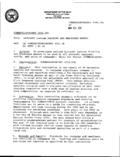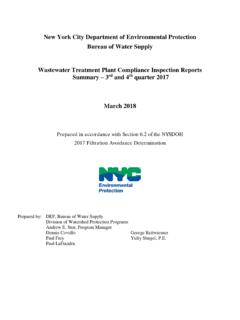Transcription of Wastewater Treatment Plant Compliance Inspection …
1 NEW york city DEPARTMENT OF ENVIRONMENTAL PROTECTION BUREAU OF WATER SUPPLY Wastewater Treatment Plant Compliance Inspection Reports Summary 1st Quarter 2011 April 26, 2011 Prepared in accordance with Section of the November 2007 United States Environmental Protection Agency Filtration Avoidance Determination Summary of SPDES Compliance inspections of East-of-Hudson and West-of-Hudson Wastewater Treatment plants Prepared by: Wastewater Treatment Plant Compliance and Inspection Programs Bureau of Water Supply Division of Watershed Protection and Panning Andrew E. Stor, Program Manager Dennis Covello George Reitwiesner Paul Frey Yuliy Shugol, Paul LaFiandra NYCDEP WWTP Inspection Program EPA FAD Deliverable April 2011 TABLE OF CONTENTS I.
2 Introduction Inspection Program Goals Inspection Program Structure Compliance Inspection report Content NYC Watershed Rules & Regulations - WWTP Upgrades II. Wastewater Treatment Facility Compliance Inspection Reports West-of-Hudson East-of-Hudson Andes (T) Carmel Sewer District #2 Boiceville (V) Clear Pool Camp Chichester (H) Hill Sparrow (The Fairways at Hill & Dale) Delaware County BOCES Lake Plaza Delhi (V)
3 Lewisboro Elementary School DMV Nutritionals Non-Contact Cooling Water Mahopac Elka Park Meadows at Cross River Condominiums Fleischmanns Michelle Estates Grahamsville (V) North Castle and Harrison Pump Stations Grand Gorge (V) Ralph Morando Building (inactive) Hanah Country Club Waccabuc Country Club Hobart (V) West Lake Sewer Extension Hunter (V) Hunter Highlands Kraft Dairy Non-Contact Cooling Water L'man Achai, Camp Machne Tashbar, Camp Margaretville (V) Morningstar/Ultra Dairy Non-Contact Cooling Water Mountain View Estates Mountainside Farms Worcester Creameries (Lagoon) Oh-Neh-Tah, Camp Olive Woods (Woodstock Percussion) Onteora Jr.
4 /Sr. High School Oorah Camp Pine Hill (V) Prattsville Richardson Hill Road Landfill Roxbury Lift Station Roxbury Run Village Stamford (V) Tannersville (V) Timberlake, Camp Walton (V) Windham (T) 2 NYCDEP WWTP Inspection Program EPA FAD Deliverable April 2011 Introduction The New york city (NYC) Watershed supplies drinking water to nearly 8,000,000 NYC residents and an additional 1,000,000 residents of upstate communities. The watershed area consists of approximately 1900 square miles of lands in upstate New york and includes a system of natural and man-made tributaries, which directs the source waters, via subsurface aqueducts, to a series of reservoirs and controlled lakes. Drinking water quality is dependent chiefly on maintaining the quality of the source waters that supply the reservoirs within the watershed.
5 Therefore, the source waters must be protected from Wastewater Treatment plants (WWTP) that are located within the watershed. To maintain and continue to provide a safe drinking water supply, the New york city Department of Environmental Protection (DEP) has taken a leadership role in upgrading, and encouraging other communities within the watershed to upgrade their respective Wastewater Treatment facilities. Preventing the degradation and contamination of the source waters and reservoirs must include continuous monitoring and a periodic comprehensive review of the Wastewater Treatment plants that are located within the watershed. The WWTP s in the watershed vary greatly in size and Treatment levels, and provide service to municipalities, institutions, commercial businesses, seasonal camps, and private residences.
6 To ensure that these plants are being operated and maintained in accordance with the limits and conditions established in their State Pollutant Discharge Elimination System (SPDES) permits, DEP has an ambitious program of inspecting all Wastewater facilities within the watershed on a quarterly basis. In addition, DEP has expanded its sampling program to include regular monitoring of the effluent parameters of all Treatment plants in the watershed. A comparative analysis of DEP monitoring data along with the facility self-monitoring effluent readings establishes patterns of Compliance . DEP uses the results of the sampling to assist Plant operators, or to initiate enforcement activities as necessary. Inspection Program Goals A number of goals are targeted for the Wastewater Treatment Facility Inspection Program.
7 A primary goal of the program is to identify operational and maintenance (O&M) improvements which will enhance the facility s ability to meet and/or exceed existing SPDES requirements. DEP personnel will share their technical expertise with Plant management and operators to offer easy-to-implement operational changes, which may result in significant improvements to the Plant s operation. For example, following a DEP Inspection of a Treatment facility which was having difficulty meeting its phosphorus limits, DEP technical staff recommended that the operator vary the install of a baffle around its settling tank. Within two weeks of this adjustment, the Plant was able to meet its phosphorus limit. As a result of the Inspection , capital upgrades may also be recommended to ensure long-term Compliance with SPDES permit requirements or greater ease and reduced cost of operations.
8 Following an Inspection and review of DEP sampling and the facility s self-monitoring data, if the problems are not evident or easily resolved; the DEP may require that non- Compliance be addressed by the permittee through an independent evaluation of the facility. If a facility is not willing to address non- Compliance to the conditions of its SPDES permits or if an adequate response is not given, the case will be referred to DEP s legal counsel for follow-up enforcement action. DEP has taken enforcement actions against a number of Wastewater Treatment facilities in the watershed for specific violations of their SPDES permits. Under Clean Water Actions filed by the city of New york , Wastewater Plant owners are often required by DEP legal counsel to enter into orders of consent by which they agree to remediate their facility and return to Compliance with the SPDES permit.
9 Regular inspections by DEP personnel ensure that the repairs and/or corrections are being completed in accordance with the consent order. 3 NYCDEP WWTP Inspection Program EPA FAD Deliverable April 2011 Regular inspections will also allow DEP to follow-up on instances of non- Compliance , mistakes or problems with self-monitoring reporting or record keeping, or modifications or expansions to the facility. Inspections will also allow DEP engineers to maintain a good working relationship with the Treatment Plant operators in the watershed. Inspection Program Structure DEP has a staff of professional engineers and technicians experienced in Wastewater Treatment facility design and operations. The staff conducts scheduled inspections for all year-round operating Wastewater facilities every quarter (four times per year), and inspections in two out of four quarters for seasonal operating facilities, groundwater remediation sites, or industrial permits.
10 To provide for continuity, each staff member is assigned specific facilities for their responsibility. Those staff members, involved with the inspections, have familiarized themselves with their assigned facilities by developing process flow schematics and obtaining as-built drawings and operation and maintenance manuals, where possible. Self-monitoring and DEP sampling data is updated and assessed regularly by the staff person. This data is evaluated to determine if the facility is in Compliance with the permitted effluent limits. Following the inspections, the reports are sent to the facility owner and operator, the New york State Department of Environmental Conservation (NYSDEC), and the New york State Department of Health (NYSDOH), or County/local Health Department, where appropriate.















